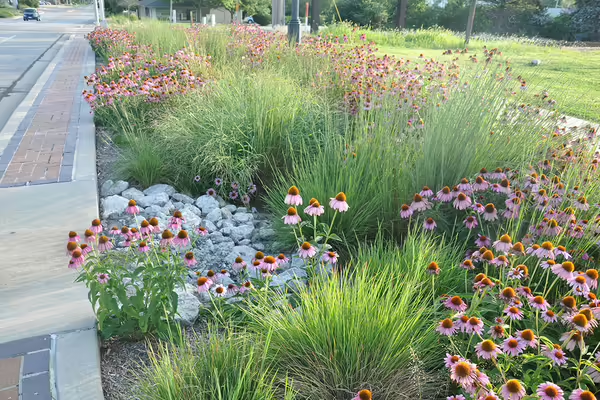
URBANA, Ill. — When floods happen, communities are forever changed. University of Illinois Extension is rising to meet the challenge by developing a program that trains municipalities how to maintain nature-based solutions that supplement their stormwater infrastructure.
Floods are the most common and expensive natural disaster in the U.S., and Illinois is expected to see increased rainfall over the next 30 years, according to the 2021 Illinois Climate Assessment. Most municipal systems are not built to handle the intense rainfall events and the resulting millions of gallons of stormwater running off impermeable roofs, streets, and sidewalks. Nature-based solutions, also known as green infrastructure, mimic natural processes by allowing water to soak into the soil, helping to prevent and reduce flood risks. Landscaping-based installations such as native plant rain gardens or green roofs capture and reduce runoff while also improving water quality.
With support from a USDA National Institute of Food and Agriculture grant, Illinois Extension is expanding its rainfall management outreach by creating an online course that provides communities with the tools, information, and demonstrations they need to establish and maintain green infrastructure projects.
“What we’ve found is that because nature-based solutions are relatively new, communities may not know how to maintain them, and that’s a barrier to adopting green infrastructure at a large enough scale to make an impact during flood events,” said C. Eliana Brown, Illinois Extension water quality and stormwater specialist and director of the project.
The course will enable municipality staff in communities across the state to increase their resiliency against flooding disasters.
The project is funded by the USDA NIFA Smith-Lever Special Needs Competitive Grants Program. This program supports innovative, education-based approaches to address disaster preparedness and responses to disasters caused by natural, human-made, or technological hazards that contribute to the exposure or vulnerability of a community.
Explore solutions for rainfall management from Extension at go.illinois.edu/RainfallManagement. From learning how to sell food from a home kitchen to applying pesticides to farm fields, Illinois Extension provides a variety of online courses and certifications. Explore available courses at Learn @ Illinois Extension.
University of Illinois Extension develops educational programs, extends knowledge, and builds partnerships to support people, communities, and their environments as part of the state's land-grant institution. Extension serves as the leading public outreach effort for University of Illinois Urbana-Champaign and the College of Agricultural, Consumer and Environmental Sciences in all 102 Illinois counties through a network of 27 multi-county units and over 700 staff statewide. Extension’s mission is responsive to eight strategic priorities — community, economy, environment, food and agriculture, health, partnerships, technology and discovery, and workforce excellence — that are served through six program areas — 4-H youth development, agriculture and agribusiness, community and economic development, family and consumer science, integrated health disparities, and natural resources, environment, and energy. Learn more at extension.illinois.edu.